Ilse Crawford
The uncanny prescience of London’s pre-eminent home maker.
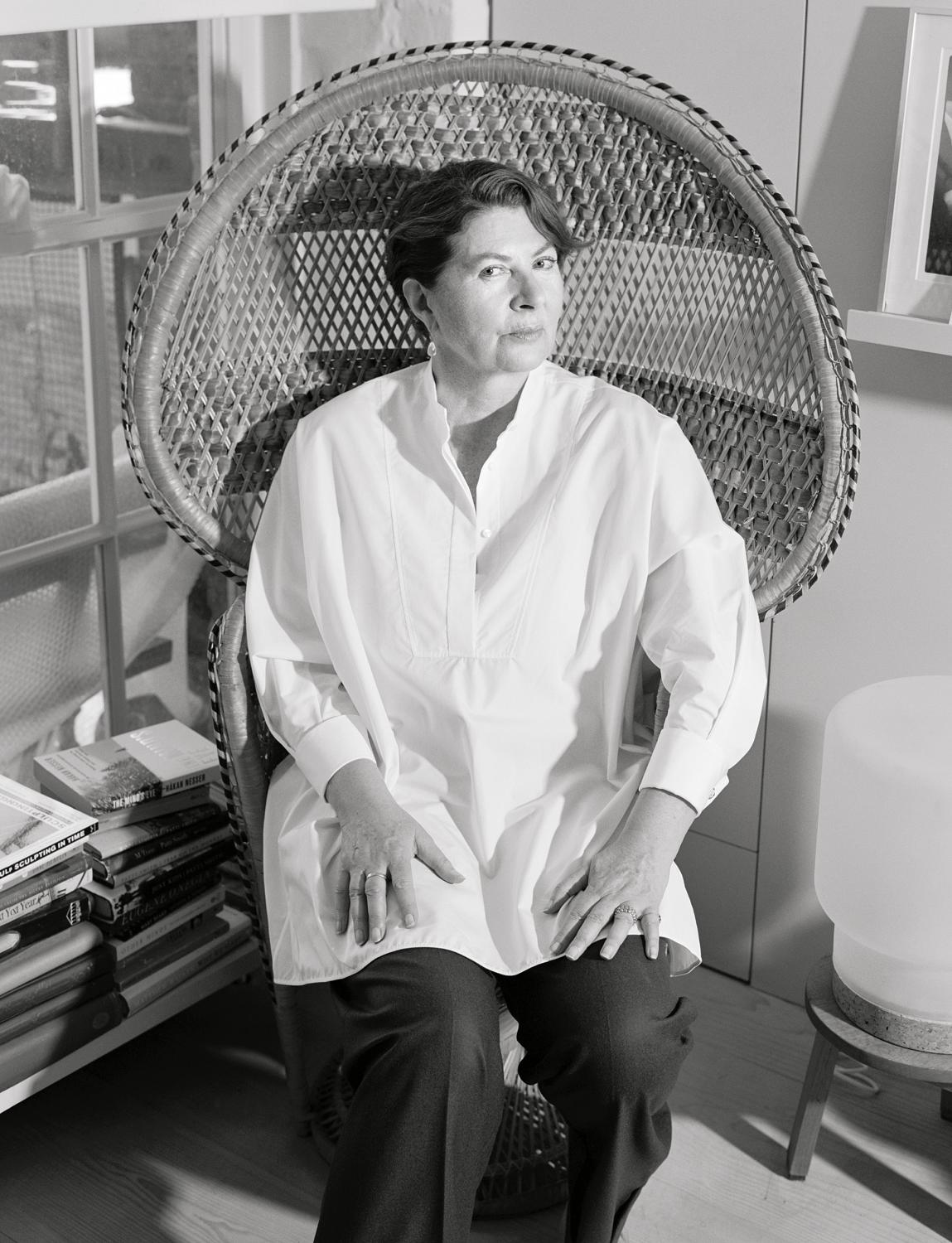
The interior designer Ilse Crawford, 58, is on a radical mission: to make people feel at home. This requires not just a comfortable sofa – wider and less deep to accommodate our new plugged-in way of living – but empathy, interrogation, and an uncommon warmth and tactility. Thirty years in the business have made it clear to the all-seeing Londoner that luxury is attention to detail, the spare room is a waste of space, and the tape measure is a blissfully simple essential tool.
If Ilse Crawford, one of the most culturally and socially engaged designers of our time, were to appear on Mastermind, her specialist subject might be storage. Fifteen per cent of a home is the absolute minimum tolerable amount of space you should give over to it, she declares. Kitchen cupboards are useless for access, she adds. “We end up using only what’s at the front. I’m a big believer in the idea that you only use the things you see.” She has given this a lot of thought. At 27, she was the launch editor of Elle Decoration, gaining ingress to all manner of houses, including those of Emmanuelle Alt, Peter Saville, Marianne Faithfull and Nicolas Ghesquière. She is the mastermind behind Babington House, described by The Guardian as “the very, very last word in country retreat”. And five years ago, with her company Studioilse, she launched a sustainable range for Ikea, including a birdcage-like bamboo lamp whose enduring worldwide ubiquity its creator describes as “amazing and absolutely hilarious. I mean, how could you plan that?”
We are in Ilse’s loft in Bermondsey, south-east London, which she shares with her husband and colleague, Oscar Peña, an expert in product development. Wearing a cream hemp- and-cotton shift dress, Ilse, 58, sits barefoot and sideways on a vast brown velvet sofa, drinking tea from an “indestructible” Iittala Teema mug. An idiom she uses sporadically is that something or other “scrubs up well”, and this also applies to Ilse, whose sleek ponytail amplifies the dominant planes of her expressive face.
The apartment occupies a generous 200 square metres (with 30 cubic metres – measured by her architects – dedicated to storage) of the fourth floor of Neckinger Mills, a handsomely fenestrated former tannery with a busy railway track on one side and a tower block on the other. Perhaps what makes the space seem so vast is that all of it is in daily use. Indeed, the very notion of a spare room, particularly in a metropolis, contravenes one of Ilse’s abiding laws of human habitation. “If a room (or building for that matter) isn’t used, something dies; these spaces always develop a weird atmosphere,” she wrote in 2014’s A Frame for Life, her third book on how interiors should enrich our time on earth – 87 per cent of which was spent indoors even before lockdown became part of the equation.
In Neckinger Mills, overnight guests will see one half of design’s most garrulous power couple disappear into the “hellhole” (as Ilse terms the huge storage space behind their bed) to retrieve a gigantic inflatable mattress. “It’s one of the really good ones, with an electrical pump,” tanned, talkative Oscar enthuses. So much better than a fold-up sofa bed, Ilse agrees: “You always get your fingers caught, and they always go weird in the middle of the night.”
Ilse’s loft is above her identically sized studio, into which seven years ago she moved Studioilse, the company she set up in 2003. She employs around 15 people – “We have journalists, we have strategists, we have interior designers, architects and product designers who work together” – on projects all over the world. They design furniture and take on residential commissions from Antibes to St Petersburg, as well as remaking the very infrastructure of companies in the light of Studioilse’s research in the field. And while many of Ilse’s long-time aesthetic preoccupations – such as grey paint (“White is the least neutral colour for a wall”) and the globes and grids of Michael Anastassiades’ ultra-flattering lighting – have been absorbed into the lingua franca of contemporary aspiration to a near-neutralising degree, it is Ilse’s unapologetic, unassailable common sense that really distinguishes her.
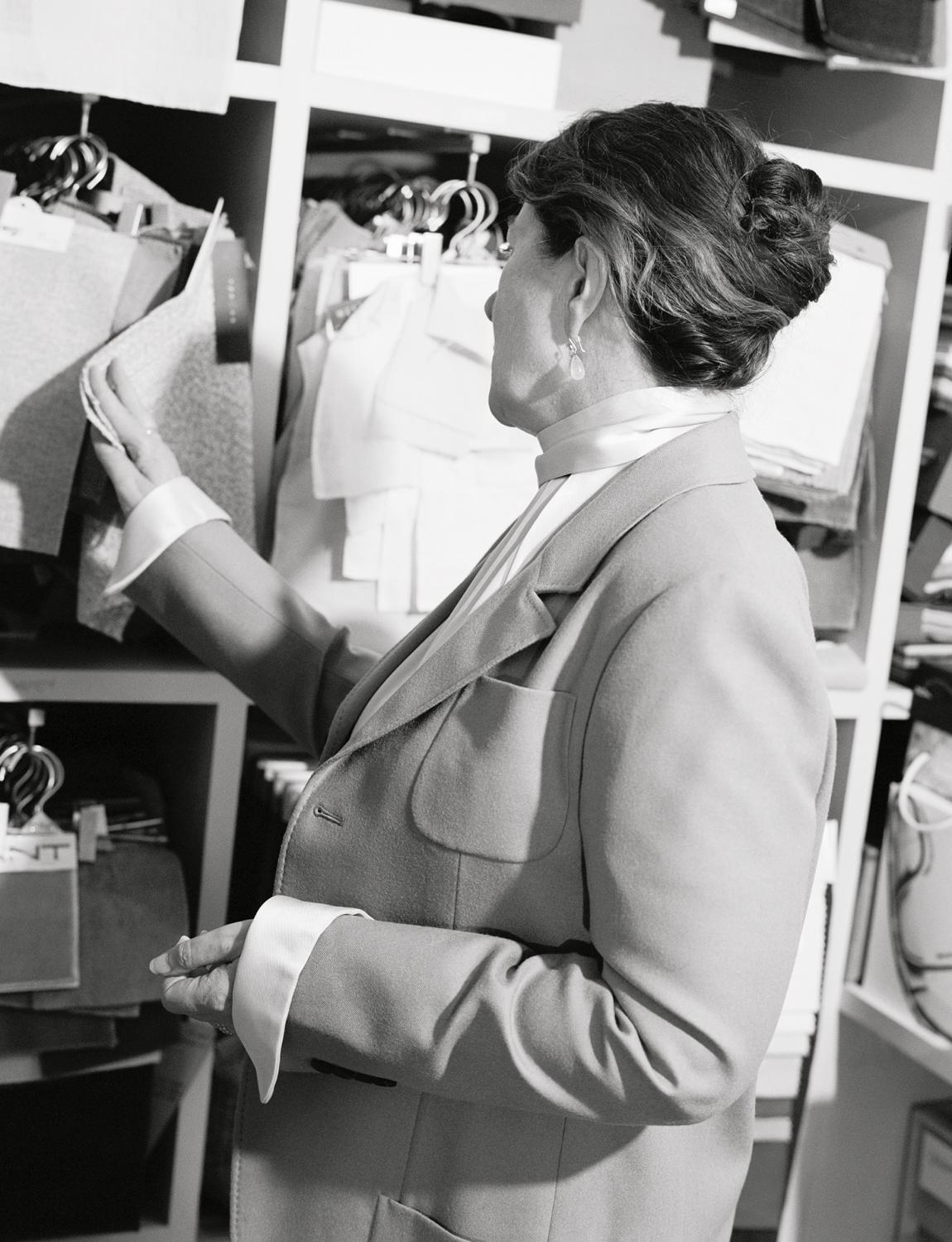
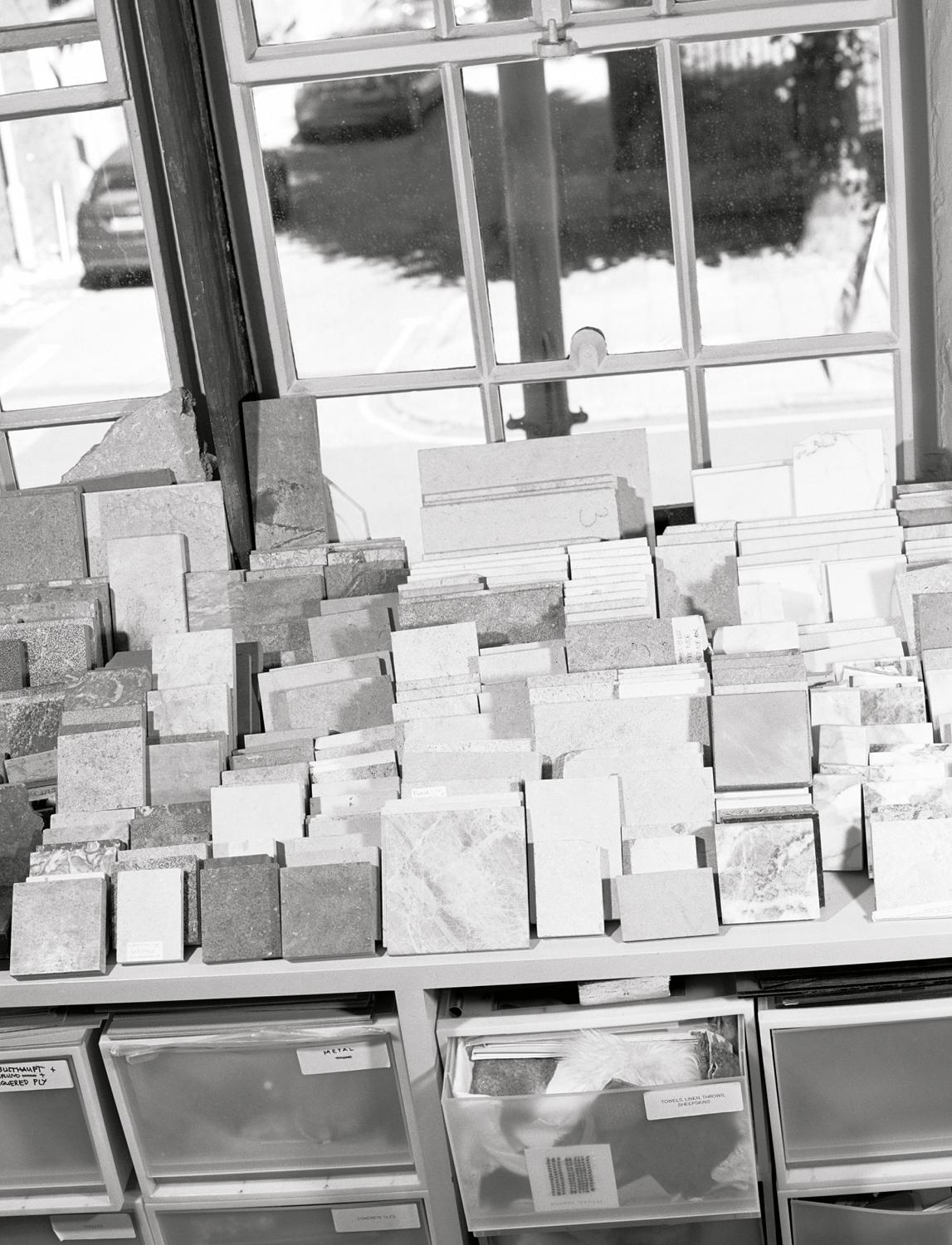
A selection of the studio’s materials samples, quite possibly containing the Next Big Thing in the world of interiors. Ilse is wearing a camel wool three-button jacket by CONNOLLY, worn over a cream polyblend Lavaliere dress by LOEWE. In the opening image, she’s in a white cotton shirt with a mandarin collar by CHLOÉ and dark brown wool-flannel trousers by CONNOLLY. Ilse wears her own jewellery throughout.
Ilse is the eldest child of Jill Rendall, an artist, and Malcolm Crawford, who was the economics editor of The Sunday Times. She grew up in “a two-up two-down worker’s cottage by the goods railway line” in Shepherd’s Bush, west London. Her mother was, she says, a free-spirited bohemian who taught Ilse to paint walls and dye clothes (“We didn’t wash the saucepan, so our food was often dyed, too,” she says, laughing). Her father’s “big thing” was “interrogate everything”.
Ilse’s brother, Alex, was born when she was 16 months old. When she was 17, they hitchhiked from the bottom of the driveway all the way to Istanbul. Alex now lives in Chile (“No idea what he’s up to,” she tells me).
Then, when Ilse was six, triplet sisters were born (one of whom, thrillingly, would go on to work as Sarah Michelle Gellar’s stunt double in Buffy the Vampire Slayer and play the helmeted pink ranger in the Mighty Morphin Power Rangers superhero children’s TV series and film). “I understand triplets are a disaster for most families,” she says matter-of-factly. “It’s just too much. You just can’t get around fast enough, you know?” The family moved to a derelict vicarage in Kent. “It didn’t have furniture except for a table tennis table, which is why it became a kind of youth club,” Ilse says. “When my dad wanted to get rid of all these kids who’d piled in, he’d put Monteverdi’s Vespers on. He didn’t believe in authority; he had other, more devious tools.”
At 11, Ilse won a place at a girls’ grammar school in Tunbridge Wells, some 20 miles from the vicarage, and rather than navigate several bus journeys and a train on a daily basis, she moved into a bed and breakfast, where she lived for 18 months. While the “awful” landlady watched television downstairs, Ilse immersed herself in Vogue. She particularly loved its “More Dash than Cash” pages and the model Marie Helvin.
Life took another turn when she was 13 and her mother was diagnosed with cancer. In the years that followed, Ilse helped to run the household (“I became a master of big-pot cooking,” she says). Her mother died in 1980. She had planned to go to the University of York, but instead went to Bedford College in Regent’s Park so she could come home more easily. On one occasion she returned to find one of the triplets walking on the back of the local garage mechanic in a pair of blue stilettos. “I threatened to confiscate her pocket money.”
After graduating, and though she had seen first-hand that journalism could be, as she puts it, “bumpy, perhaps not a steady job,” Ilse nevertheless followed her father into the profession, first as a copy editor at The Architects’ Journal, then as a sub-editor at The World of Interiors, where she was soon promoted to deputy editor, focusing on “the modern side” of the magazine’s aesthetic remit. And then in 1989, when she was 27, Ilse was recruited by Sally Brampton, the “fearless” late editor of Elle, to launch the British incarnation of the French interiors title Elle Décoration, initially a freebie with Elle. “There were five of us in the back room doing this supplement,” Ilse says. “I think we kind of went under the radar a bit.”
Late-1980s interior design was uncompromising and angular – the equivalent of shoulder pads and six-inch heels. Ilse ushered in a different sensibility from the start. “We were definitely pushing the boundary in terms of what the publisher thought was acceptable in an interiors magazine,” Ilse says. She remembers being summoned on a regular basis to Paris, where a senior colleague would give her a dressing-down, then divide her magazine’s pages into two distinct piles: one for good taste, one for bad. “I’m interested in things that are alive, and I’m not interested in perfection,” she says now. It was this, she thinks, that made British Elle Decoration such a success. It quickly went from appearing biannually to bimonthly and then monthly. As The Wall Street Journal said, it electrified the home-magazine genre “with images of real people reading the newspaper around soulfully modern kitchen tables.”
This approach was partly informed by modest budgets, Ilse maintains. One of her favourite shoots, by the photographer Henry Bourne, had members of the public holding African stools on Golborne Road in west London. “Everybody else was doing shoots in studios, and we were wandering the streets, grabbing a bunch of people who looked interesting,” she says. “It was all about the sort of philosophy that really appeals to me – mixing the affordable with the special, finding beauty in everyday things and, equally, celebrating the value in the special things.”
Ilse left Elle Decoration in 1998 to concentrate on her own projects. Nick Jones, the owner of Soho House, became her first client when he asked her to do the interiors for Babington House, in Frome, Somerset. “Her feel on the place was inspirational,” Jones tells me. “She looked at the traditional Georgian Grade II listed country house and made it contemporary.” Ilse says she challenged Jones’s vision of a country house hotel, luring him in the direction of a relaxed interior that made his young media-industry clientele feel they’d been left the keys to the drinks cabinet.
“Design is the easy bit,” she says. “What you want is for someone suddenly to get excited and look at the same horizon as you, so that they feel genuinely thrilled by the process. That way you end up learning from each other.”
Ilse has continued to work with Jones on projects such as Cecconi’s restaurant in Mayfair, the Electric Cinema in Notting Hill and Soho House New York, membership of which became a byword for the good life in 2000s NYC.
For all Ilse’s conviction, the author and critic Alice Rawsthorn says she is the antithesis of the stereotype of the megalomaniacal stylist. “Her work is always focused on the well-being of the people who will use it, to make them feel comfortable, confident and at ease.” Almost every “soft-modernist interior or object we come across owes something to her,” Rawsthorn continues, “as does the obsession with well-being and wellness.”
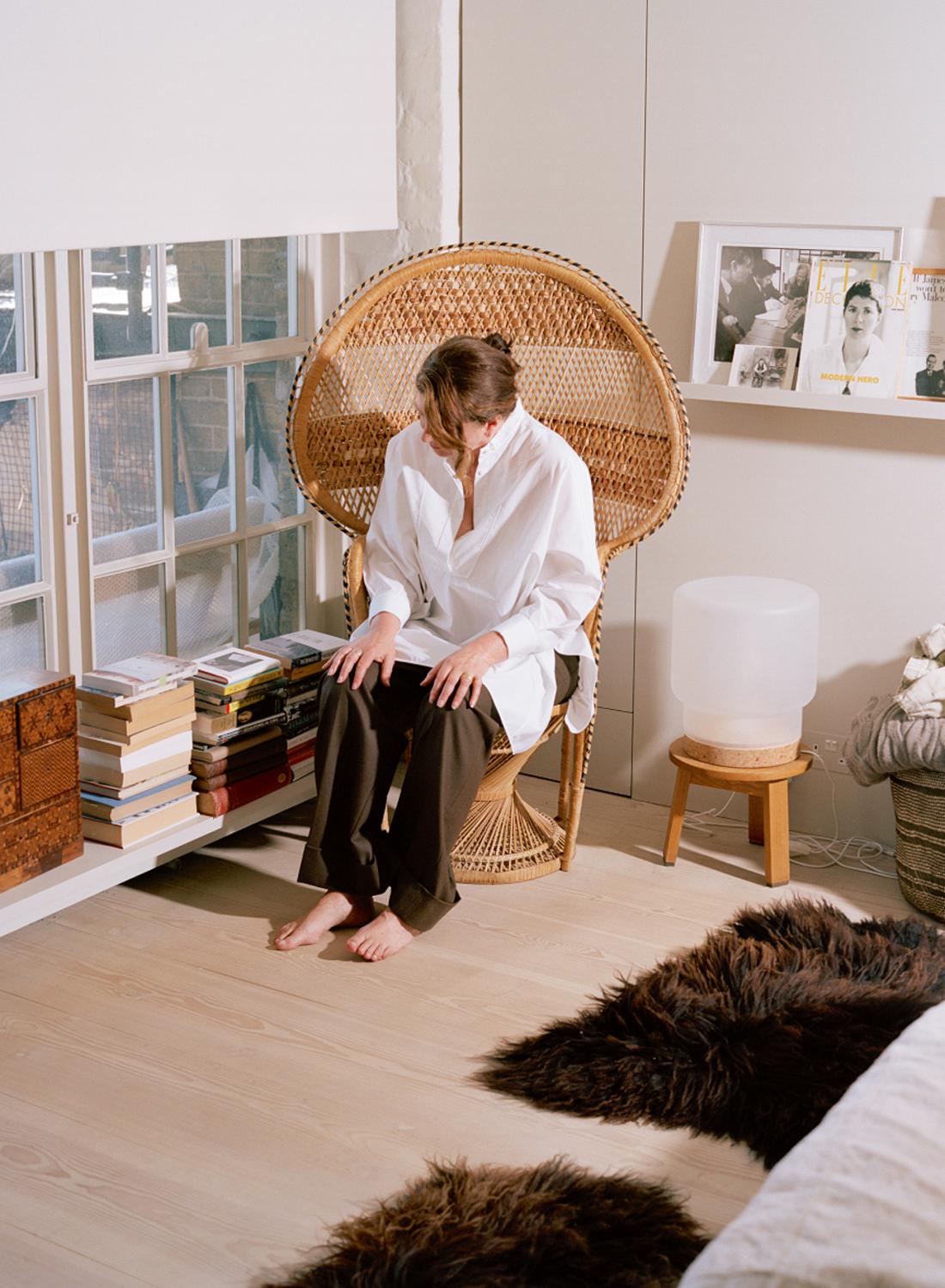
Ilse Crawford was photographed in her home and her studio in Bermondsey, London. Just south of the Thames, the area boasts many converted warehouse spaces, though there are no prizes for guessing which is the best decorated.
That “obsession” was already apparent when Ilse published her first book, Sensual Home, in 1997. It was groundbreaking in its suggestion that the speed of modern life demanded that our homes be oases of tranquility and calm. And it brought Ilse into Donna Karan’s orbit, to head up her new home division in New York. “The money was amazing, but it was surreal,” Ilse says. “But the thing about being one of those people plucked from London is that you’re in a sort of golden cage. I should have just turned up at 11 with a nice hairdo.”
The lighting designer Michael Anastassiades remembers Ilse approaching him to work on some lines for Karan. “I knew that she never had a training in design, but for me it was much more about her philosophy in general, about life and living, something that you carry with you,” he says. “I immediately had trust in her.” (Anastassiades later taught Ilse ashtanga yoga in his Waterloo home; it is a practice she has maintained on and off through the years. “I totally lack Michael’s monk-like discipline!”)
After two years in New York, she was, she says, faced with the decision every expat career girl is. “Option A is you stay in corporate life and you get more black cashmere and maybe some drugs and a cat,” she says. “Or a husband. Those two are interchangeable, but always black cashmere. Option B is to leave.”
Before she left New York, Ilse was approached by Li Edelkoort, the chairwoman of the Design Academy Eindhoven, to run its new Man and Well-Being course (she resigned the post last year, after two decades, to concentrate on Studioilse). Man and Well-Being: the very concept could be considered the basis for all her work. She has an uncanny prescience for the way we live, want to live and will be living soon. During our conversation she predicts the imminent mainstreaming of furniture rental, particularly in the case of design classics, “things made from better materials, that have real character.” Two weeks later, it is announced that John Lewis, Middle England’s stalwart department store of choice, will begin leasing big-ticket items to a generation that’s grown up entirely comfortable with the idea of subscription thanks to Netflix and vegetable box deliveries.
In Eindhoven, under her tutelage, students made headlines for pushing the boundaries of design way beyond the usual parameters of, say, ergonomic seating – see Brigitte Coremans’s tiny coffins for babies born before the Dutch health system’s “viability border” of 24 weeks in utero, designed to fulfil the parents’ unmet need for an official burial. “I think design is often mistaken for an aesthetic,” Ilse says. “But the fact is, it can build new realities.” She has frequently said that she is interested in what makes us feel at home in the world “and how design can play a meaningful role in that.”
Perhaps the neatest example of this ethos is Ett Hem, the boutique hotel in Stockholm which Studioilse completed in 2012. Its owner Jeanette Mix remembers working with Ilse as “time-consuming, challenging and even scary” but ultimately an intensely rewarding experience. “Ilse works with core values, discussing every little detail before even considering design decisions or looking at mood boards,” Mix says. “She made a truly exceptional effort in getting to know me and remains by my side together and forever.” The result is the apotheosis of Ilse’s take on hospitality: service that anticipates guests’ needs to an extreme degree, presented in a homely manner. There’s an honesty policy at the shake-it-yourself cocktail bar, full-sized Verso products in the bathrooms, and one of Ilse’s beloved hammams in the basement. Most of all, though, by removing the physical delineations between the front and back of house, she completely reengineered the relationship between guests and staff.
“Give most space and the most money to the things you do most; if that happens to be bed, fine!”
More recently, Ilse has been involved with the world of multinational corporations. “Even a 70 per cent success rate with a huge company can be more profound than 100 per cent uptake with five smaller projects,” she says.
In the case of Cathay Pacific, the airline whose network of first- and business-class lounges she reimagined in 2016, Ilse challenged the conception of such spaces as an opportunity to gorge on free food and drink pre-departure. Instead, she proposed a restorative haven where “knackered” passengers could seek sustenance in every sense. “They hadn’t touched their lounges in 20 years, and you could see that,” Ilse says. All-you-can-eat buffets gave way to a now-celebrated noodle bar where fresh, nourishing wonton noodle soup is presented to order from an open kitchen – a “stage” that chefs and servers can take pride in.
And although the airline had wanted to eliminate sofas because they encourage unsightly napping, Ilse campaigned for designated nap rooms with low lighting and partitioned daybeds – something I was personally grateful for when I connected at Hong Kong airport in the throes of a particularly foul migraine. “I’m so happy,” she says when I tell her about this experience.
Studioilse’s relationship with Ikea, meanwhile, has extended way beyond the realm of her sustainable cork dining tables of 2015. “It’s a super-functional company, and they pull us in on a consultancy basis when they need us,” Ilse says. A recent research project has involved exploring the sustainable future of the scented candle – no trifle when you consider the massive volumes of product at play. An Ilse-centred episode of the Netflix design documentary Abstract showed the Studioilse team getting to grips with the Ikea cafe and the reality that its 100-million-units-per-year meat hot dog might be here to stay. “Often we’re trying to find a bridge between the ethics that they want to have and the reality of where they are right now,” Ilse tells me.
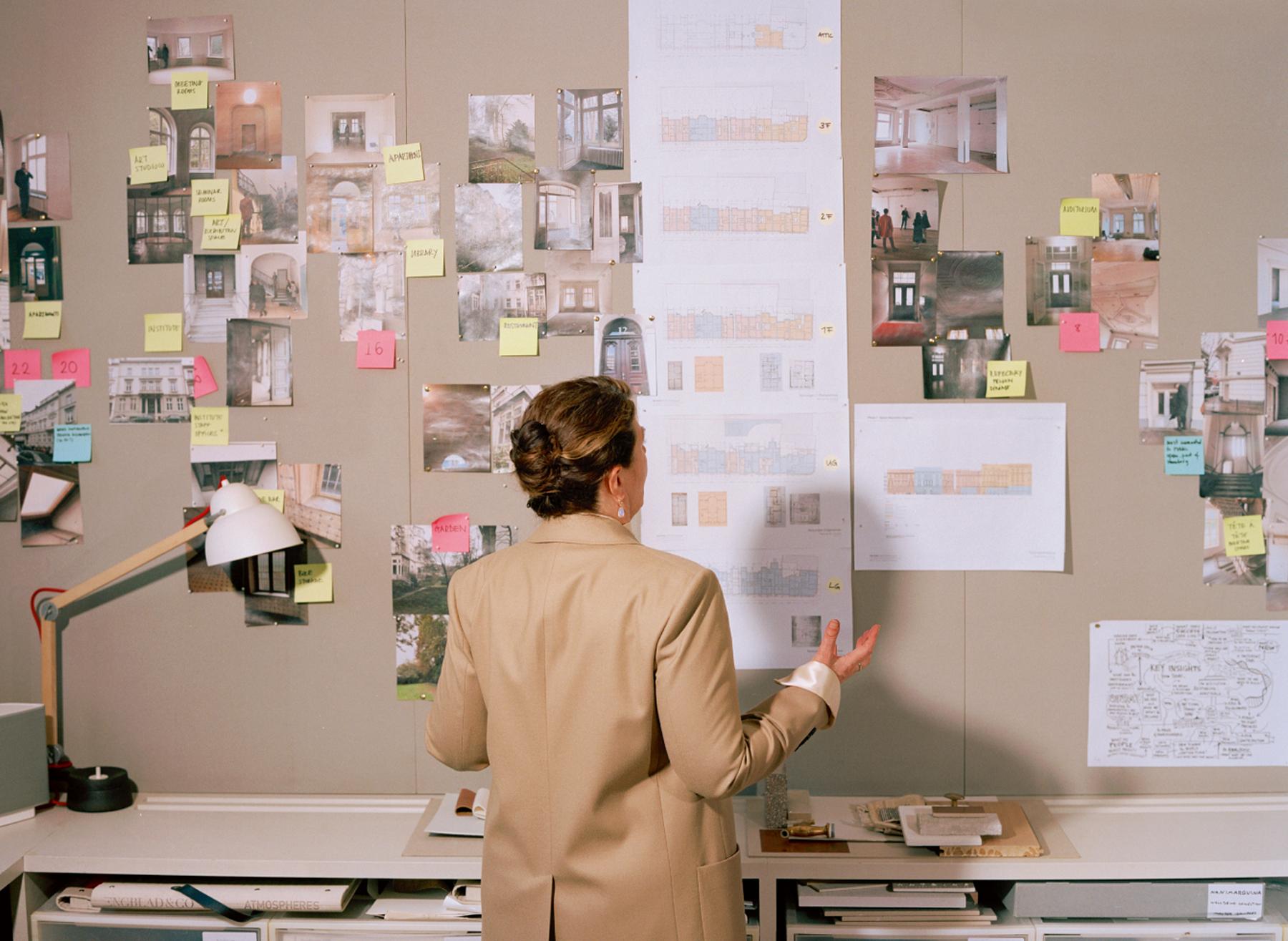
Founded in 2003, Studioilse works across a number of interdisciplinary projects at any one time, ranging from interior spaces large and small to products and furniture. Its mission is simple — to create environments that make people feel comfortable.
But it’s not just the corporate multinationals. “It’s important that we do take our skill set to a different sector,” Ilse says. Take the Anna Freud Centre, a child mental health organisation in London, and the associated Pears Family School, for children with emotional and behavioural difficulties. Despite the comparatively “tiny” budget of £37,000, when Studioilse set about “deinstitutionalising” it in 2019, Ilse was adamant that its users should receive no less a feeling of “warmth, calm and safety” than Cathay Pacific’s first-class passengers. “It’s really important for the designers to keep their feet on the ground and stay connected to reality, dealing with all the layers of accountability that go with projects like that. The budget may be different, but I don’t think that means it has to be less beautiful.”
The same was true in 2017 when Studioilse redesigned the historic St Cuthbert’s drop-in centre in Earl’s Court, London, to create a home for Refettorio Felix, a community kitchen that provides healthy meals for those living on the margins of society. Ilse’s primary objective, she told Dezeen at the time, was to add “a universal pleasure that is often missing from social projects.” The transformation of the hall into a glorious green “dignified dining space” replete with (donated) Vitra chairs, Alessi tables, Artemide lighting and plants from Conservatory Archives proved so appealing that the charity has gained an extra revenue stream from com-panies wanting to hire it as an inspiring alternative to the hotel conference suite.
“I don’t think we realised that would happen,” Ilse says of this virtuous cycle. “But it’s a direct consequence of believing, as I do, that everybody deserves the same quality of space. We’re all human, and the space that brings people together should be dignified and human.”
Ilse goes on to say that one of the most instructive moments of her career came from talking to a woman at Refettorio Felix. “She was working as a lawyer when her daughter, who was a young teenager, disappeared – just disappeared. She never found her, and her whole life unravelled, just like that. It made me think: Something dramatic like that could happen to you; you, too, could end up losing the plot. So I think it’s important never to forget that it’s always ‘us’, not ‘them’.”
Ironically, the reason Ilse’s transformative interventions tend to be so successful is that she takes as her starting point the messy realities of the human condition rather than some Instagram Valhalla where we’re all living our best lives. In terms of domestic space, she says, we too often fixate on objects rather than how we spend our time, which is the most telling marker of our priorities.
“Do an audit where you measure how much time you spend in each space during the day,” she advises. “Follow yourself through 24 hours during the week, 24 during the weekend, maybe the difference between summer and winter. And design your living space around your reality, and you will be much happier. There’s no point spending way too much money on a kitchen you never use. Give most space and the most money to the things you do the most, and if that happens to be bed, then fine! Spend the money on a good mattress and nice sheets and a good reading light. Just be honest.”
Mark SmithLondon-born, Amsterdam-based Mark has edited titles including Time Out Amsterdam and the Soho House members’ magazine. His investigative podcast series, Safe House, is rumoured to be coming soon. His first contribution to The Gentlewoman was in Issue nº 15, and he has been our digital editor since…read more Portraits by
Alice NealeLondon-based photographer Alice Neale graduated from Central Saint Martins in 2015 and has worked with some of the most celebrated magazines and fashion brands in the UK and Europe such as AnOther, Re-Edition, Noon,The New York Times, Prada, Miu Miu, Rimowa and Wales Bonner. Alice is represented by Artistry.read more
Styling: Flo Arnold. Hair: Franziska Presche at the Together Company. Make-up: Mattie White at Saint Luke. Photographic assistance: Barney Couch. Production: Artistry.
This profile was originally published in The Gentlewoman nº 22, Autumn & Winter 2020.